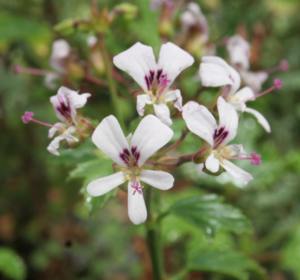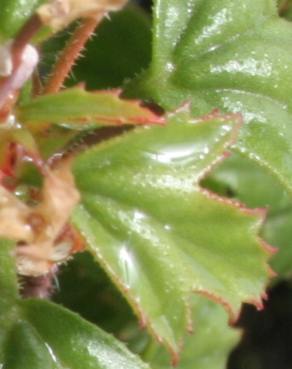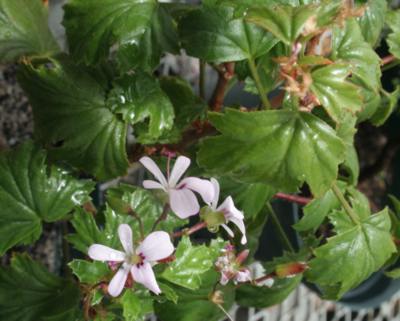Pelargonium scabroide
Pelargonium scabroide R.Knuth
Family: Geraniaceae
Common names: no names recorded
Introduction
A fairly small pelargonium suited for small rockeries in partially shaded areas.

Description
Description
Pelargonium scabroide is a decumbent to erect branched shrub, 0.70 m high and 0.5 m in diameter. The stems are green and soft when young but become woody as the shrub matures. Numerous glandular hairs are present, interspersed with long and soft to stiff and bristly hairs which are wine-red but age to greyish-brown when older. The leaves are cordate with wine red serrate-dentate leaf margins, rough to the touch.

The flowers are white to pale pinkish purple and are borne in an umbel-like inflorescence. This species flowers during the hot summer months and has been recorded in flower from November to February.
Conservation Status
Status
Pelargonium scabroide is listed on the National Red List of South African plants as Least Concern (assessed February 2009, http://redlist.sanbi.org).
Distribution and habitat
Distribution description
Pelargonium scabroide has a small distribution range on the mountain ranges between Porterville and Touws River. It is found mainly in shaded areas provided by overhanging sandstone boulders which create a rather moist habitat. The species grows in coarse sandy soils. The distribution region experiences snowfalls regularly during winter, and summers are very dry and hot.
Derivation of name and historical aspects
History
William Henry Harvey, an Irish botanist, divided the pelargoniums into 15 sections. The diagnostic features for the different divisions were based on leaf and flower characteristics and habitat. Pelargonium scabroide is classified under the section Pelargonium which consists of profusely branched, often woody shrubs. The section contains well known species such as P. citronellum , P. graveolens and P. capitatum which are also grown for their essential oils in the perfume industry.
P. scabroide belongs in the family Geraniaceae, a large family of 11 genera and 800 species in subtropical and temperate regions of the world. The South African genera in the Geraniaceae family are Monsonia , Sarcocaulon , Pelargonium , Erodium and Geranium. There are approximately 270 species of Pelargonium which occur in S, E and NE Africa, Asia, St Helena, Tristan da Cunha, Madagascar, Australia and New Zealand, most of which (± 270 species) occur in southern Africa and ± 150 species are found in fynbos. Pelargoniums are often wrongly called geraniums.
Pelargonium gets its name from the resemblance of the shape of the fruit to the beak of a stork, which is pelargos in Greek. The epithet scabroide refers to the surface of the leaves which is rough to the touch.
Ecology
Ecology
Pelargonium seed is interesting in that, attached to the elliptic seed is a feathered, tail-like structure that is coiled in a spiral arrangement. This tail causes the seed to twist around in the wind and drill itself into the soil in a corkscrew fashion, thus ensuring that most seeds produced (5 seeds per flower) have a good chance of germinating (Brown, N. & Duncan, G. 2006).

Uses
Use
Although Pelargonium scabroide has no cultural use, it has horticultural potential and can be grown in light shaded areas of your garden. This part of the garden should also have a bit of moisture in the soil for the plant to thrive. The white flowers will provide beautiful colour to the shaded part of the garden. It is also ideal for any small rockery that is partially shaded. This species is fairly small, so plant it among other smaller herbaceous perennials. Pruning is essential to keep the shrub neat and tidy and this also promotes new growth shoots.
Growing Pelargonium scabroide
Grow
Pelargonium scabroide can be propagated from cuttings and seed. Cuttings can be taken at any time of the year from healthy vigorous plants, from softwood or herbaceous growth, preferably after the flowering and seeding period. Using a rooting hormone will speed up the rooting process, especially for the softwood cuttings. Place the cuttings in river sand in cold frames and keep them moist. The cuttings should root within 4 weeks. Give the rooted cuttings a 2-week weaning period and transplant them into a well-drained potting soil mix and place them in a sunny position. Once the plants have formed a strong root ball they can be planted out into the garden section you have specially prepared for them to be displayed and enjoyed by others.
Sow seeds in late summer to early autumn. The seeds should be sown in a light, well-drained potting mix. Sprinkle the seeds evenly in the seed tray and cover them with fine-milled pine bark. Water the seeds gently but thoroughly with a fine-nozzled watering can and place them in light shade with no direct sun. Seed germinates within 3 weeks. Plants grown from seeds will flower within 12 to 18 months. Pelargoniums grow very well outdoors, free of any diseases, but if the same plant is grown indoors or in a greenhouse the warmer climatic conditions and lack of air circulation usually result in pests such as mealy bug, aphids, white fly or rust and powdery mildew. Consult the nearest garden centre to find out what the latest and best suited pesticides and fungicides are for the problems.
References
- Brown, N. & Duncan, G. 2006. Grow fynbos plants . South African National Biodiversity Institute. Cape Town.
- Van der Walt, J.J.A. 1977. Pelargoniums of southern Africa . Purnell, Cape Town.
- Van der Walt, J.J.A. & Vorster, P.J. 1988. Pelargoniums of southern Africa , vol. 3. Kirstenbosch National Botanical Gardens, Cape Town.
Credits
Trevor Adams
Kirstenbosch Botanical Gardens
March 2013
Plant Attributes:
Plant Type: Shrub
SA Distribution: Western Cape
Soil type: Sandy
Flowering season: Late Summer
PH: Acid
Flower colour: White
Aspect: Shade, Morning Sun (Semi Shade), Afternoon Sun (Semi Shade)
Gardening skill: Average
Special Features:
Horticultural zones











Rate this article
Article well written and informative
Rate this plant
Is this an interesting plant?
Login to add your Comment
Back to topNot registered yet? Click here to register.